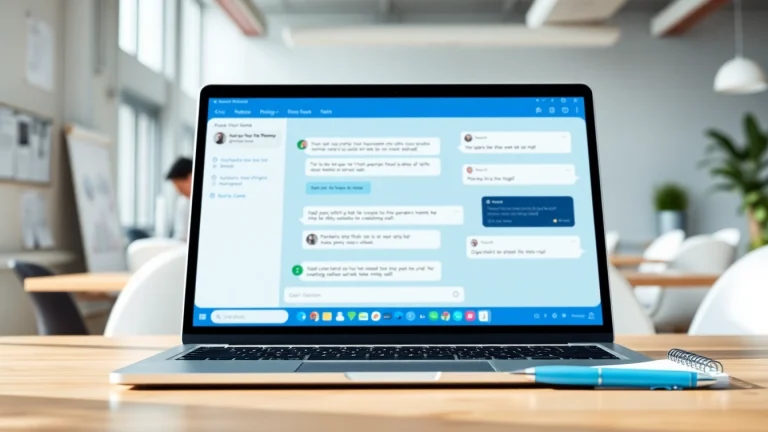
How AI Chat Bots are Transforming Business Communication
Understanding the Role of AI Chat Bots
What is an AI Chat Bot?
AI chat bots are software applications designed to simulate human-like conversations with users via text or voice interactions. These programs leverage artificial intelligence, particularly natural language processing (NLP), to understand user requests, process information, and respond intelligently. The scope of AI chat bots spans various functionalities including customer service, information retrieval, and interactive applications for both business and personal use.
Increasingly, organizations are turning to ai chat bots to enhance user experience, automate repetitive tasks, and provide 24/7 support. With advancements in machine learning, these chat bots continue to evolve, learning from interactions to become more intuitive and effective over time.
Historical Development of AI Chat Bots
The history of AI chat bots traces back to the 1960s, exemplified by programs like ELIZA, created by Joseph Weizenbaum. ELIZA was a primitive form of chat bot capable of mimicking a psychotherapist, albeit through simple keyword recognition and pattern matching. In the decades that followed, chat bot technology evolved significantly with the introduction of more sophisticated AI techniques, notably in the realms of NLP and machine learning.
By the 1990s, chat bots began to take on more complex tasks, integrating into customer service functions. The advent of the internet paved the way for more interactive and engaging chat bots that could operate via web interfaces. The rise of social media and messaging platforms in the early 2000s further catalyzed the integration of AI chat bots, leading to sophisticated virtual agents seen in today’s applications.
Common Use Cases in Business
AI chat bots have become invaluable across various business sectors due to their versatility and efficiency. Some of the most prevalent use cases include:
- Customer Support: Chat bots can handle inquiries, resolve issues, and provide relevant information, improving customer satisfaction and reducing wait times.
- Lead Generation: They can engage potential customers through personalized interactions, gather information, and qualify leads for sales teams.
- Appointment Scheduling: Many businesses utilize chat bots to streamline the booking process, allowing customers to schedule appointments seamlessly.
- E-commerce Assistance: Chat bots can help users browse products, answer inquiries about availability, and guide customers through the purchasing process.
Benefits of Implementing AI Chat Bots
Enhancing Customer Engagement
One of the most significant benefits of AI chat bots is their ability to enhance customer engagement. By providing immediate responses to inquiries, they create a more interactive and satisfying customer experience. Chat bots can facilitate conversations at any time of day, ensuring that customers feel valued and heard regardless of their time zone.
Furthermore, with advanced machine learning algorithms, chat bots can personalize interactions by recalling past conversations and tailoring responses based on user preferences. This level of personalization fosters loyalty and encourages users to engage more with the brand.
Operational Efficiency through Automation
AI chat bots significantly improve operational efficiency by automating repetitive tasks that would otherwise consume valuable employee time. By handling routine inquiries, data collection, and other low-level tasks, chat bots free up human agents to focus on more complex issues that require empathy and critical thinking.
Additionally, their ability to process and analyze large volumes of data swiftly allows businesses to make informed decisions based on real-time user insights. This capability helps organizations quickly adapt to customer demands and preferences.
Cost Reduction Strategies via AI
Implementing AI chat bots can lead to significant cost savings for businesses. By minimizing the need for extensive customer support teams, companies can allocate resources more efficiently. The initial investment in creating and implementing chat bots often pays off in the long run through reduced staffing costs and improved service efficiency.
Moreover, chat bots can significantly lower customer acquisition costs by enhancing lead generation and improving conversion rates. The ability to handle numerous customer interactions simultaneously without the need for a proportional increase in staff marks a critical financial advantage in competitive markets.
Challenges in AI Chat Bot Deployment
Technical Hurdles in Implementation
The deployment of AI chat bots is not without its challenges. Technical hurdles such as integration with existing systems, ensuring robust performance during peak loads, and maintaining accurate NLP models can complicate the implementation process. Companies must invest in proper training data and continuous model improvement to ensure that chat bots deliver accurate and relevant responses.
Furthermore, businesses must also consider the complexity of managing multiple channels where chat bots will be deployed. Ensuring consistency in user experiences across these platforms can present additional challenges.
User Acceptance and Experience Issues
Another common challenge is user acceptance. Users may not always respond positively to chat bots, particularly when interactions fail to meet their expectations. A poorly designed chat bot can lead to frustration and a negative perception of the brand. Businesses must ensure that their chat bots are intuitive, easy to use, and can handle a variety of situations effectively.
To facilitate user acceptance, companies should provide clear communication about the capabilities of their chat bots and ensure that users can easily transition to human support when necessary. This creates a supportive environment while still leveraging the efficiencies of AI solutions.
Data Privacy and Security Concerns
Data privacy and security are paramount, especially considering that chat bots often deal with sensitive customer information. Organizations must comply with regulations such as GDPR and CCPA, which mandate stringent data handling and protection measures. Failure to ensure data security can not only harm a company’s reputation but also result in substantial financial penalties.
To mitigate these risks, businesses need to implement robust security protocols, educate users on privacy practices, and ensure transparent data handling processes, upholding user trust throughout interactions.
Best Practices for Developing Effective AI Chat Bots
Defining Clear Objectives and Use Cases
A successful AI chat bot begins with clearly defined objectives. Businesses should identify specific use cases that align with their goals and audience needs. By having clear objectives, organizations can better design and implement chat bots that function effectively within their operational frameworks.
This process involves assessing customer pain points and determining how chat bots can address those needs, thereby ensuring the bot provides real value to users from the outset.
Integrating Feedback for Continuous Improvement
The development of AI chat bots is an iterative process. Continuous improvement should be the guiding principle throughout a bot’s lifecycle. Collecting user feedback is crucial; organizations should regularly analyze interactions to identify areas of improvement.
By applying user insights and data analytics, businesses can adjust the chat bot’s capabilities, refine its responses, and enhance overall performance. This practice not only helps in troubleshooting but also aids in aligning the bot’s functions with evolving customer expectations.
Ensuring System Interoperability
Effective AI chat bots require integration with existing systems to function optimally. Ensuring interoperability means that the chat bot can communicate seamlessly with other platforms, such as customer relationship management (CRM) software, ticketing systems, and analytics tools.
Leveraging APIs for system integration fosters a more holistic customer experience and allows for real-time data exchange, which is vital for providing accurate solutions during user interactions.
Measuring the Impact of AI Chat Bots
Key Performance Indicators (KPIs) to Track
To understand the effectiveness of AI chat bots, it is essential to establish key performance indicators (KPIs). Common KPIs include:
- Customer Satisfaction Score (CSAT): Measures user satisfaction with chat bot interactions.
- First Response Time (FRT): Tracks the time taken for the bot to respond to initial user inquiries.
- Conversation Completion Rate: Indicates the percentage of interactions that successfully resolve the user’s query.
- Cost Savings: Assess the financial impact of chat bot deployment relative to human support costs.
Regularly monitoring these KPIs provides valuable insights into a chat bot’s performance and areas for improvement.
Case Studies of Successful Deployments
Numerous organizations have successfully implemented AI chat bots and reaped the rewards. For instance, companies like H&M and Sephora have integrated chat bots into their retail experience, enhancing customer engagement and personalizing shopping journeys. H&M’s chat bot assists users in selecting outfits, while Sephora’s chat bot provides personalized beauty consultations, demonstrating the effectiveness of tailored AI interactions.
Another case study is Domino’s, which employs a chat bot that allows customers to order pizza via messaging platforms. This commitment to innovative technology has helped increase efficiency and boost sales, showcasing how chat bots can transform traditional business models.
Future Trends in AI Chat Bot Technology
The future of AI chat bots is bright, with several trends anticipated to shape their evolution. Increased integration of machine learning will result in chat bots becoming more adept at understanding context and sentiment, enabling them to provide even more personalized interactions. Additionally, advancements in voice recognition and speech synthesis will enhance the capability of voice-activated chat bots, making them more user-friendly.
Moreover, as businesses strive for enhanced omnichannel experiences, we can expect chat bots to become more interoperable and capable of functioning seamlessly across various platforms and environments. The push for ethical AI development and transparency in decision-making processes will be crucial as organizations seek to maintain trust with their users.


